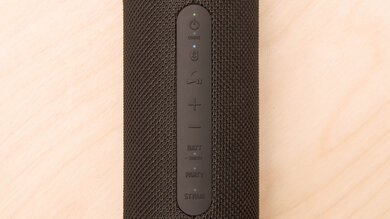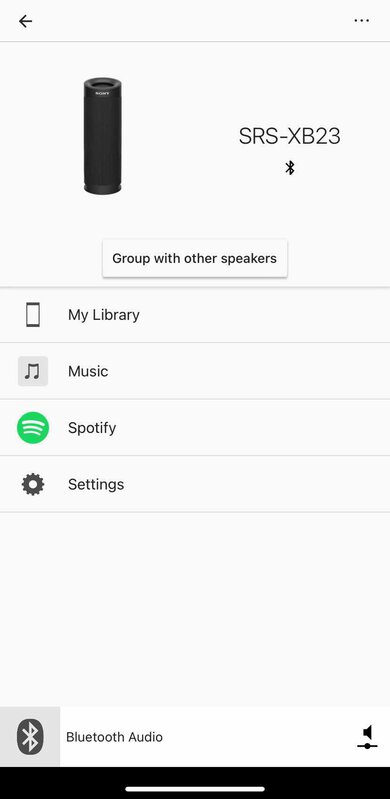The Sony SRS-XB23 is a portable cylindrical speaker. Thanks to its cylindrical design, its soundstage is perceived as wide and spacious. While its sound profile lacks low-bass out-of-the-box, it also has a graphic EQ via its companion app, which is nice if you like to tweak its sound profile. Unfortunately, it doesn't get very loud, and there are compression artifacts at max volume. That said, it's durable and well-built, making it a suitable option if you're looking for a speaker that you can take with you outdoors.
Our Verdict
The Sony SRS-XB23 isn't bad for music. Its sound profile has a touch of extra boom in the bass range, and it can sound a bit veiled due to its recessed treble. That said, vocals and lead instruments are still reproduced pretty clearly and accurately. Also, you can customize its sound using the graphic EQ in the Sony Music Center app. However, even with its Extra Bass feature turned on, it still struggles to reproduce the deep rumble in the low-bass, so it's not ideal for bass-heavy genres like EDM.
- Graphic EQ.
- Very portable and well-built design.
- Extra Bass feature.
- Doesn't get very loud.
- Doesn't support Apple AirPlay, Chromecast, or Wi-Fi.
- Lacks low-bass.
The Sony XB23 is middling for videos and movies. It has fairly low latency with both Android and iOS devices, so you shouldn't notice a delay between the audio you hear and the video you see. Some apps can compensate for latency differently, though, so your real-world experience may vary. This speaker doesn't get very loud, unfortunately, and it can't reproduce the deep rumble found in action-heavy scenes.
- Graphic EQ.
- Very portable and well-built design.
- Doesn't get very loud.
- Doesn't support Apple AirPlay, Chromecast, or Wi-Fi.
- Lacks low-bass.
The Sony XB23 is decent for podcasts. Dialogue is reproduced pretty clearly and accurately, though voices can also sound a bit veiled due to its recessed treble. It also doesn't get very loud. On the upside, its portable design makes it easy to bring this speaker with you from room to room.
- Very portable and well-built design.
- Doesn't get very loud.
The Sony SRS-XB23 is compatible with the voice assistants on your paired smartphone. Per our testing methodology, we use a series of recorded voice commands to test a speaker's voice assistant performance to ensure consistency across our reviews. However, like other Sony Extra Bass speakers we've tested, the Sony XB23 didn't respond to these recorded commands. It did register commands given in a normal speaking voice, but this isn't part of our testing process.
- Very portable and well-built design.
- Doesn't get very loud.
- No built-in voice assistant.
The Sony XB23 is satisfactory for outdoor use. It has a very lightweight, portable design, so you can easily bring it with you on the go. There's even an adjustable strap to help you attach it to your bag or backpack. It has an IP67 rating for dust and water resistance that certifies it to be fully dust-tight and immersible in up to a meter of water for 30 minutes. Unfortunately, it can't get very loud, so it can't fill up a large space with your audio.
- Graphic EQ.
- Very portable and well-built design.
- Doesn't get very loud.
- Lacks low-bass.
Changelog
- Updated Apr 18, 2024: We've updated this review based on user feedback to remove any mentions of its omnidirectional design.
- Updated Jul 05, 2023: Added market comparison with the Sony SRS-XB100 in the Portability box.
- Updated Aug 19, 2022: Added a comparison with the Sony SRS-XE300 in the 'Frequency Response Accuracy' box.
- Updated Aug 09, 2022: Added a comparison with the Sony SRS-XE200 in the 'Voice Assistant' box.
Check Price
Differences Between Sizes And Variants
The Sony SRS-XB23 comes in several color variants: 'Black', 'Olive Green', 'Orange', 'Coral Red', 'Sky Blue', and 'Taupe'. We tested the Black variant, and you can see its label here. We expect each of the color variants to perform similarly to our model.
If you come across another variant, please let us know in the discussions and we'll update our review.
Popular Speaker Comparisons
The Sony XB23 is a cylindric speaker that's part of Sony's Extra Bass lineup. It has a smaller, more portable design than the Sony SRS-XB33 and the Sony SRS-XB43, but it doesn't come with customizable RGB lighting, and it doesn't offer Sony ClearAudio+ to automatically adjust the speaker's sound field based on your audio content. That said, unlike the Sony SRS-XB12, it's compatible with the Sony Music Center app, and it comes with a graphic EQ for sound customization.
See also our recommendations for the best portable speakers, the best Bluetooth speakers, and the best Bluetooth speakers for bass.
The Sony SRS-XB23 is slightly better than the JBL Flip 6, though they have different strengths. The Sony can play stereo content without downmixing it to mono, which is more immersive. It has a longer-lasting battery life of over nine hours. It supports voice assistants through your smartphone, though its performance isn't very good. It also has lower Bluetooth latency with iOS and Android devices, making it better suited for watching movies and videos. That said, the JBL has a more neutral and balanced sound profile out of the box. It can get a bit louder with less compression present at max volume, so audio doesn't degrade as much as you increase the volume. It's also smaller, making it more portable.
The Sony SRS-XB23 is a better speaker than the JBL Flip 5. The Sony is better built, can play stereo content, and has longer-lasting continuous battery life. It also has a companion app with a graphic EQ so you can tweak its sound to your liking. However, the JBL can get a bit louder with fewer compression artifacts.
The Sony SRS-XB23 is a slightly better speaker than the Sony SRS-XB13 overall. The XB23 can produce a more extended low-bass than the XB13, and is more customizable thanks to the graphic EQ featured in its companion app, so you can tweak its sound to your liking. That said, the XB13 is smaller and more portable than the XB23. Also, while it doesn't get as loud, it has fewer compression artifacts present at max volume, so your audio sounds cleaner at louder volumes.
The Sony SRS-XB23 is a more premium speaker that's better than the Sony SRS-XB100. The SRS-XB23 is a little bigger but offers a better sound overall. It can playback stereo content without downmixing it to mono, and its companion app brings more customization tools to the table, like a graphic EQ. You may prefer the SRS-XB100 if you want a smaller, more portable speaker, especially since it has better battery performance.
Test Results

The Sony XB23 has a cylindrical design. You can place it vertically or horizontally, depending on your preferences. There are passive radiators on each end, and most of the speaker is protected by thick webbing. It comes in several colors, so you can find a shade that suits your style. For a speaker with a fairly similar design, check out the JBL Flip 4.
This speaker is exceptionally portable. You can easily carry it with one hand, and it has a strap to suspend it from a hook. It's also fairly lightweight. Since it has a battery, you can also use it outside. If you want a similar speaker that's even smaller, check out the Sony SRS-XB100.
The Sony SRS-XB23 has a great build quality. It has a durable build, and most of it is wrapped in a thick netting. The removable strap is also quite thick and sturdy, and you can adjust it based on your preferences. There's even an IP67 rating for dust and water resistance that certifies it to be fully dust-tight and immersible in up to a meter of water for 30 minutes.
The Sony SRS-XB23 has physical controls on the side that allow you to manage calls and audio. They're easy to use, and there are mini display lights on some of the controls to let you know the speaker's status. If you want to skip the track forward, you can press the play button twice. You can also skip backward by pushing the play button three times. You can hold the battery button for three seconds to enter 'Stamina Mode', which turns off the Extra Bass feature to help conserve battery life. There are also dedicated buttons for party mode as well as stereo pairing.
The Sony XB23 has mediocre frequency response accuracy. We tested this speaker horizontally with its Extra Bass feature turned on to simulate the average listener experience. Its sound profile has a touch of extra boom in the bass range, and its recessed treble can make audio sound a bit veiled. It also struggles to reproduce the deep thump and rumble in the low-bass found in bass-heavy music like EDM. Thanks to its balanced mid-range, vocals, and lead instruments still reproduce pretty clearly. There's also a graphic EQ available in the Sony Music Center app so you can customize its sound. For a Sony speaker that can produce a more extended low-bass, check out the Sony SRS-XE300.
The Sony SRS-XB23 has a very good soundstage. Thanks to its cylindrical design, it has decent directivity that means audio sounds quite consistent across different listening angles. You can set the speaker to either mono or stereo mode via the Sony app. If you want to feel immersed in your favorite music, you can also check out the Marshall Emberton, which has a better soundstage.
The Sony SRS-XB23 has a disappointing dynamics performance. It doesn't get that loud, and there are a lot of compression artifacts at max volume. If you want a speaker that reproduces audio more clearly at max volume, check out the DOSS SoundBox Plus.
The Sony SRS-XB23 has a very good battery performance. It has over nine hours of playback time and turns off after approximately 15 minutes to conserve battery life. You can turn this feature on and off via the companion app. There's even a Stamina Mode that turns off the Extra Bass feature to help save battery life. Ultimately, battery life can vary according to usage, so your experience may differ. If you're looking for a similarly-styled speaker with better battery performance, check out the Sony SRS-XB33 or the Sony SRS-XB43.
As part of our testing methodology, we use recorded voice commands to activate the speaker. However, like other Sony Extra Bass speakers we've tested, the Sony SRS-XB23 has trouble registering these recorded commands and doesn't respond. While it can register commands from a normal speaking voice, this isn't part of our testing process. For a Sony speaker with a better voice assistant performance, check out the Sony SRS-XE200.
The Sony Music Center is a very good app. It's compatible with both iOS and Android. You can use it to pair two speakers together to create a stereo pair or link them together to play the same audio to cover a larger space. This app also includes a graphic EQ, meaning you can tweak its sound to your liking.
You can't use the Sony SRS-XB23 wired. It comes with a USB-C cable for charging the speaker.
The Sony SRS-XB23 has an excellent Bluetooth performance. It can connect with up to two devices at a time, and it has an outstanding range. It also has low latency on iOS and Android, which is great if you watch videos. However, some apps and devices compensate for latency differently, so your experience may vary.






